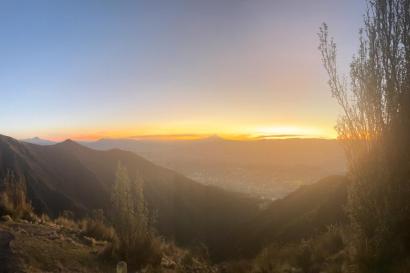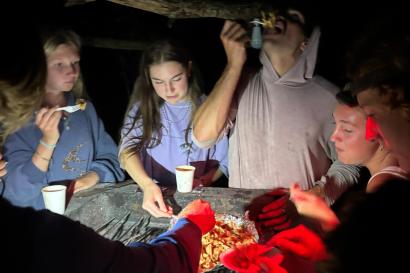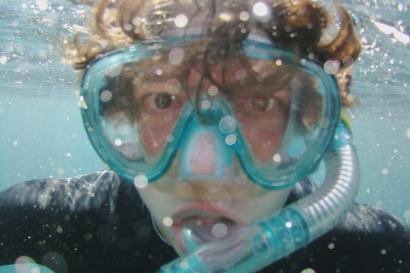A few days back, my Socio-Ecosystem Development class took our first field trip here on the Galapagos: a day out on a new tour boat, exploring the interplay between eco-tourism, conservation and social justice in this unbelievable place.
Here is what I wrote in response.
(Yesterday) When we were motoring to shore in the zodiac, I looked back across the water and saw The Beagle. It grew smaller and smaller in its azure crib, high masted and regal, and when we stepped into the surf the sand felt warm with history, as if it had just been there. We walk in the footprints of Darwin. The green hills of San Cristobal, dappled with shadow, the lazy beat of a frigatebirds’ wings above—things unyielding, unchanging, forever.
Of course, this listless fantasy—frozen in some misplaced perception of time—runs counter to core components of Darwinian thought and the pressing realities of life in the Galapagos. It is a potent curse and a powerful blessing. The goat droppings scattered like bleached seeds across the lava flow take on a transcendent malevolence. The dive boats on the horizon begin to feel like an insulting contradiction is disguise. And this is one of conservation’s central conundrums, exemplified. What is to be conserved? A memory, or a template for future memories? A history, a present, or a future? How do you contain that which is always, necessarily, changing?
In a way, Darwin has both saved and doomed the Galapagos. His legacy is as potent a memory as ever, begging to be remembered in full– every lava rock, every cove, every scuttling crab enshrined for eternity. Yet it was Darwin’s insightful observations of change that made his time on the Galapagos so monumental, and each tourist that steps into his prints and feels time stand still is doing a disservice to the revolutionary spirit of Darwin’s ideas. Nothing stands still.
I got a better look at The Beagle from the hilltop, the one we walked to over hollow lava tubes and crumbling basalt. The sails were tucked away, and it had an outboard motor. The ribbons of light reflected on its fiberglass hull were cast by waves filled with micro-plastics. The Martin landscape behind us, a healing crust over earth’s open wounds, may have only been a few decades old in places. This was not The Beagle. Not even close. This was a new ship, in a brand new place—and it had brought us here because we, students and tourists, are drunk on a history we’ll never get back.
Raul, our guide for the day, hinted at this absurdity with frequency. As we sailed back around the north coast of San Cristobal, he described the glut of tourism the Galapagos has seen over the past few decades as reeking with hypocrisy. If not overtly ill-intentioned, much of it feels cruely unaware. Luxury crafts, which can bring huge amounts of money into the local economy (or not, in some cases, as money is siphoned back to the wealthy owners on the mainland) guzzle fossil fuel and are resistant to sustainable changes as a result—the long-term impact warming seas will have on the Island’s ecosystems seem a problem for another day. Packed planes fly in and out, their engines roaring overhead. The word “eco” gets slapped on everything until it’s rendered almost meaningless. In order to keep the “original” charm of the Galapagos intact—thus maintaining the flow of tourism revenue—the original inhabitants (not indigenous peoples, but settlers with generations of local history) are now shut out from large portions of their own island, turned away from their prior livelihoods into service jobs in the intensively regulated tourism sector. New inhabitants are strictly barred from the islands—Darwin’s “living laboratory” is treated an awful lot like a museum (complete with employees). Raul seemed happy to share his home with an excited world, holding onto the line with a practiced ease as his sailboat cut a hard path through tropical winds—but he acknowledged the price many don’t (or worse, refuse to).
And, of course, it’s really easy to be sympathetic to this absurdity. Some things do feel too precious to change.
We snorkeled around Kicker Rock (or Leon Dormido, as it is also called) and looked down into some the richest waters I’ve ever seen. The sun, slanting through the deep blue, sparkled off the back of immense schools of fish—twisting, turning, skimming the edge of abyss. Blacktip Reef Sharks and Green Sea Turtles cruised the water column, which felt gritty between my fingers. Tiny jellies, squirming zooplankton, braids of bubbles winding up from beneath: there was texture to the smallest spaces. And the rock, the rock, a jagged temple jutting above the waves—what kind of inconceivable forces could ever thrust up such a thing? I would occasionally lie on my back, bracing against the rolling waves, to stare skyward. The frigatebirds hung suspended, like kites, in slow rotation around the highest spires. Red-billed Tropicbirds, paper thin like origami, skimmed the cliff-face with their long white tails streaming behind. I could never do this for long (while I don’t fear the sharks, I do like to keep tabs on them) but the rolling continuum of sea and sky, fins and feathers, truly took my breath away.
Kicker Rock is a really popular tourist spot. The nearby town of Puerto Baquerizo Moreno seems to relate with it closely—and, having now been there, I understand the draw. It’s one of those places where time seems to stand still—the seabirds in the air, the slow drift of ancient predators through the deep—it probably is not far-fetched to say that, had Darwin had a snorkel, he would have seen a nearly identical scene. And it would feel like a crime against future generations to shatter that now collective memory were fishing regulations to be loosened or the marine reserve opened to plunder—not to mention a crime against creatures whose dignity and sentient majesty is unquestionable. But it is not as simple as that, is it? In a Heisenberg-ian twist, the very observation of this place drives its inevitable change. With each boat and plane trip the water chemistry changes, the seeds of disorder sown throughout the marine food web. Plastics are produced here, and there, and insatiable appetites for seafood blossom after a long day on the water. Is this the price we pay for collective memories? A tragedy of the commons that even communal stewardship can’t solve?
And should we be resigned to such change? Just as the finches in town are changing (Small and Medium Ground Finches losing their natural adaptations, homogenizing, with the advent of food scraps), will the changes that play out in the waters around Kicker Rock arouse our curiosity, not just our horror? What would Darwin think? Should we care?
We finished the day with drinks at a bar overlooking the waterfront, watching the sunset turn the sky pink. We laughed and swapped our photos and listened to the ubiquitous bark of Sea Lions on the docks. Boats crowded the harbor while locals and tourists alike walked the boardwalk in quiet contentment.
Where do we draw the lines of battle? What do we protect, what do we restore? When the fiercest, brightest minds in conservation and development can’t seem to agree, where do we pick our fights—and what do we sacrifice for them?
We will continue discussing these questions, but I’m afraid there may be no good answers.
Later ya'll.
Brendan

Brendan Murtha
<p>Hi everyone! My name is Brendan, and I'm a junior at Bowdoin College (Brunswick, ME) studying Ecology, Evolution, and Marine Biology. I'm passionate and curious about all things natural history related, and although my main focus has always been birds, I am just as likely to be found photographing dragonflies or catching snakes as I am craning my neck to look at the skies. These interests have also led me down paths of human ecology, conservation, and all things political, and I enjoy exploring such topics in my writing, photography, and music. I'm super excited to be part of the GAIAS program this semester, and hope to capture some of the magic through my posts.</p>








